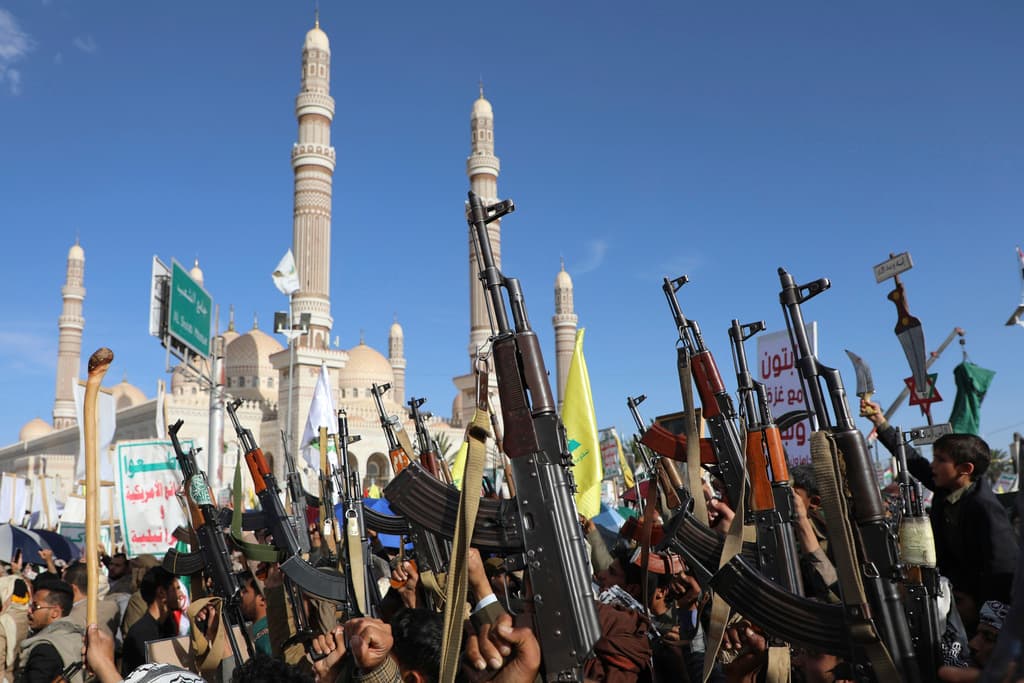Houthis Dismiss Reports That, in the Wake of U.S. Election, They Will Lift Their Blockade of the Red Sea
The Iranian proxy punctuates its vow by launching a missile at the Jewish state.

One of President Trump’s first tasks, as he tries to wind down Mideast wars and ease America’s inflationary pressures, could be to end the Houthi chokehold on maritime traffic in the Red Sea. A decisive setback for Iran’s Yemeni proxy could also send an important message in deterring America’s enemies.
The Houthis’ spokesman, Yahya Sarea, quickly dismissed reports last week that due to Trump’s election the Yemen-based terrorist group intended to lift its year-long blockade of the Red Sea. To punctuate the militant statement, the Houthis on Sunday launched a ballistic missile at central Israel, boasting a hit on a strategic military target.
While the Houthis claim to be fighting Israel on behalf of Hamas, they have also disrupted 12 percent of world commerce by attacking ships in the Red Sea. “Such a scale of attacks, using weapon systems on civilian vessels, had never occurred since the Second World War,” according to a recent report by a United Nations panel, which highlighted Iran’s arming and training of the Houthis.
“I can’t see Trump accepting the shutdown of the Red Sea and all the costs involved,” the editor of the Foundation for Defense of Democracies’ Long War Journal, Bill Roggio, tells the Sun. “If he wants to get prices down, that problem needs to be resolved.”
President Biden has conducted air strikes against Houthi military installations in Yemen, including over the weekend in a joint operation with the British. The United States Navy and other naval forces have escorted vessels in the Red Sea, and Israel twice struck Yemen’s Hodeida port, where the Houthis receive much of their arms deliveries.
The Houthis, however, are undeterred. Backed by the Islamic Revolutionary Guards Corps, they seem intent on deciding which commercial ship will be allowed to sail the Red Sea. Can new strategies be attempted?
America, for one, declined to sink the MV Behshad, an Iranian spy ship that for months has navigated the Red Sea area, overseeing the Houthi vessel targeting. Another tactic yet to be attempted, Mr. Roggio notes, is targeting Houthi personnel, including top commanders and their Yemen-based IRGC collaborators.
Then again, Saudi Arabia, which is fast becoming central to America’s Mideast strategy, objects to military action across its border, a Yemen watcher at Jerusalem’s Forum for Regional Thinking, Inbal Nissim-Louvton, tells the Sun. After failing to defeat the Houthis in a war that started in 2015, Riyadh has grown wary of Houthi attacks on its energy installations, and fears their renewal.
Like Mr. Biden, Trump is signaling he is eager to calm the Mideast, and considers Riyadh a key player in achieving that goal. At the same time, the Iranian Islamic Republic, which has crucial influence over the Houthis, is opposed to regional rapprochement centered on the Saudis.
If Trump “wants to disengage from some of this, he’s going to have to engage,” Mr. Roggio says, adding that rolling back the Houthi aggression would be a good start. “Obviously it’s not simple,” he says, “but it is something that can be done, and you don’t have to really put boots on the ground to fix that problem.”
On Sunday the Houthis boasted a successful hit at Nahal Sorek, a strategic arms depot near the Israeli city of Beit Shemesh. The Israel Defense Force reported that the Houthi Palestine 2 missile — a replica of Iran’s Fatah 1 — was intercepted outside of Israeli territory.
The “extent of transfers of diverse military materiel and technology provided to the Houthis from external sources, including financial support and training of its combatants, is unprecedented,” the United Nations panel of military, intelligence, economic, and other officials from several countries wrote last week in its 537-page report to the Security Council.
With the help of Iran and Hezbollah, the former ragtag militia fighting local rivals in one of the world’s poorest countries is now a formidable army. The number of Houthi troops, including conscripted child soldiers, is estimated at 350,000 now, up from 220,000 in 2022 and 30,000 in 2015, according to the UN report.
“The scale, nature and extent of transfers of diverse military materiel and technology provided to the Houthis from external sources, including financial support and training of its combatants, is unprecedented,” the panel’s report added.
In the 1980s the Islamic Republic built up Hezbollah in Lebanon as its frontline army against Israel. Further expanding that model, it surrounded the Jewish state with militias and armies. As Israel degrades Hezbollah and Hamas, the Houthis — originally designated to combat Riyadh — stand to become the mullahs’ top proxy army, damaging America’s interests.
Trump could prevent future military complications by dealing with the Houthis now. If allowed to further metastasize, the group and its Tehran masters could end any hope of peace — and punish America’s economy at the same time.

